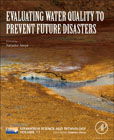
Evaluating Water Quality to Prevent Future Disasters, Volume 13 covers various separation methods that can be used to avoid water catastrophes that could arise from climate change, arsenic, lead, algal bloom, fracking, microplastics, the impact of flooding, glyphosphates, triazines, GenX, and oil contamination to avoid future water disasters. The information in this book provides a valuable resource that will help the reader solve their potential water contamination problems or help them develop their own new approaches to monitor water contamination. Highlights reasons for potential water catastrophesProvides separation methods for monitoring water contaminationEncourages development of new methods for monitoring water contamination INDICE: 1. Overview2. Solving arsenic contamination problem with separation science and technology3. Origins of Flint water crisis4. Investigating the missing link effects of noncompliance and aging private infrastructure on water quality monitoring5. Impacts of infrastructures deficiencies on potable water quality in the Republic of Serbia6. Harmful algal blooms: Their effects are global and massive and we need to mitigate them7. Methods for characterization of chemical and biological groundwater interactions with close-proximity oil and gas extraction activity8. Impacts of Deepwater Horizon oil and dispersants on various life stages of oysters Crassostrea virginica9. Integrating microplastics data into water quality monitoring protocol10. Occurrence of glyphosate and triazine residues in drainage and river waters from western Kentucky, USA11. Developing a sensitive biosensor for monitoring arsenic in drinking water supplies12. Low-cost tap water monitoring via the coffee-ring effect13. Global climate change14. Impact of flooding on water quality15. Learning from horror stories of water contamination
- ISBN: 978-0-12-815730-5
- Editorial: Academic Press
- Encuadernacion: Rústica
- Páginas: 400
- Fecha Publicación: 01/07/2019
- Nº Volúmenes: 1
- Idioma: Inglés
